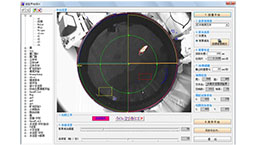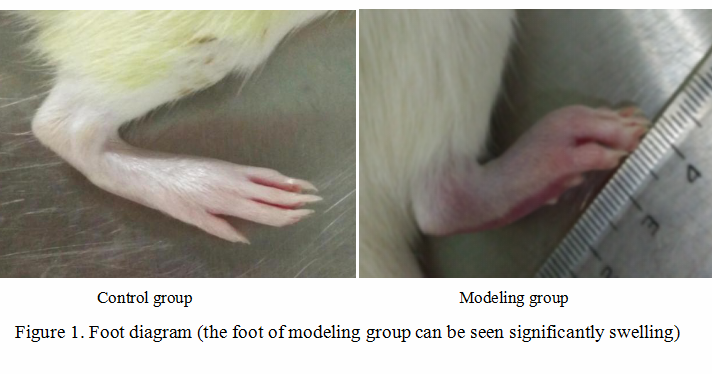Rat Model for Rheumatoid Arthritis (RA)
- Product No.DSI522Ra01
- Organism SpeciesRattus norvegicus (Rat) Same name, Different species.
- Prototype SpeciesHuman
- SourceInduced by Adjuvant
- Model Animal StrainsSD rats (SPF Class), male,180g~220g
- Modeling GroupingRandomly divided into three groups:control group, model group and test drug group.
- Modeling Period4~6 weeks
- Modeling MethodGrab anesthetized rats and inject 0.1 ml Complete Freund's Adjuvant (CFA) on the right posterior foot intradermal to induce inflammation, so as to establish the model; the control group, inject 0.01 mol/L acetic acid 0.1 ml on the right toe subcutaneous, to the exclusion of the sensitized effect in CFA solvent.
- ApplicationsThe model is used to study the pathogenesis of rheumatoid arthritis (RA) and to provide an ideal experimental model for drug efficacy.
- Downloadn/a
- UOM Each case
- FOB
US$ 200
For more details, please contact local distributors!
Model Evaluation
Weight measurement:
record the weight of rats on 0d, 7d, 14d, 21d, 28d.
Organ index:
Weigh the rats and take the thymus and spleen, saline rinses with gauze to absorb the surface moisture, respectively to measure the weight (wet weight), and calculate the organ index.
Organ index=organ wet weight(mg) /body weight(g)
Plantar swelling value:
with electronic vernier caliper to measure rat paw thickness. Left and right lateral plantar control and group control were measured on every 7 days (7, 14, 21 and 28).
Arthritis index (AI):
Arthritis index score is used to evaluate the degree of inflammation. Score each foot claw, to 0 to 4 points in the record, cumulative score is the arthritis index of each mouse.
0 points: no erythema and swelling of the evidence;
1 points: erythema and mild swelling in the middle of the foot or ankle;
2 points: erythema and mild swelling from the ankle to the middle of the foot spread;
3 points: erythema and mild swelling from the ankle to the joint spread;
4 points: erythema and severe swelling, including the ankle, foot and toe.
Pathological Results
The rats were sacrificed, specimens from the hind ankle joints, fixed, decalcified, embedded in paraffin, HE staining for histological observation. Rat in control group:ankle joint structure is normal, no inflammatory cell infiltration, synovial cells arranged in neat, smooth cartilage surface, no effusion in the joint cavity;
Rats in the model group were significantly damaged, surrounded with a large number of neutrophil infiltration, synovial hyperplasia, fibrous tissue hyperplasia, cartilage and bone damage.
Cytokines Level
Take 1mL blood from inferior vena cava and separate the serum. Assay immediately or store samples in aliquot at -80℃ for later use. Avoid repeated freeze/thaw cycles.
Using ELISA kit to assay the quantity of TNF alpha, IL-1 beta and other cytokines
Statistical Analysis
SPSS software is used for statistical analysis, measurement data to mean ± standard deviation (x ±s), using t test and single factor analysis of variance for group comparison, P<0.05 indicates there was a significant difference, P<0.01 indicates there are very significant differences.
GIVEAWAYS
INCREMENT SERVICES
-
 Tissue/Sections Customized Service
Tissue/Sections Customized Service
-
 Serums Customized Service
Serums Customized Service
-
 Immunohistochemistry (IHC) Experiment Service
Immunohistochemistry (IHC) Experiment Service
-
 Small Animal In Vivo Imaging Experiment Service
Small Animal In Vivo Imaging Experiment Service
-
 Small Animal Micro CT Imaging Experiment Service
Small Animal Micro CT Imaging Experiment Service
-
 Small Animal MRI Imaging Experiment Service
Small Animal MRI Imaging Experiment Service
-
 Small Animal Ultrasound Imaging Experiment Service
Small Animal Ultrasound Imaging Experiment Service
-
 Transmission Electron Microscopy (TEM) Experiment Service
Transmission Electron Microscopy (TEM) Experiment Service
-
 Scanning Electron Microscope (SEM) Experiment Service
Scanning Electron Microscope (SEM) Experiment Service
-
 Learning and Memory Behavioral Experiment Service
Learning and Memory Behavioral Experiment Service
-
 Anxiety and Depression Behavioral Experiment Service
Anxiety and Depression Behavioral Experiment Service
-
 Drug Addiction Behavioral Experiment Service
Drug Addiction Behavioral Experiment Service
-
 Pain Behavioral Experiment Service
Pain Behavioral Experiment Service
-
 Neuropsychiatric Disorder Behavioral Experiment Service
Neuropsychiatric Disorder Behavioral Experiment Service
-
 Fatigue Behavioral Experiment Service
Fatigue Behavioral Experiment Service
-
 Nitric Oxide Assay Kit (A012)
Nitric Oxide Assay Kit (A012)
-
 Nitric Oxide Assay Kit (A013-2)
Nitric Oxide Assay Kit (A013-2)
-
 Total Anti-Oxidative Capability Assay Kit(A015-2)
Total Anti-Oxidative Capability Assay Kit(A015-2)
-
 Total Anti-Oxidative Capability Assay Kit (A015-1)
Total Anti-Oxidative Capability Assay Kit (A015-1)
-
 Superoxide Dismutase Assay Kit
Superoxide Dismutase Assay Kit
-
 Fructose Assay Kit (A085)
Fructose Assay Kit (A085)
-
 Citric Acid Assay Kit (A128 )
Citric Acid Assay Kit (A128 )
-
 Catalase Assay Kit
Catalase Assay Kit
-
 Malondialdehyde Assay Kit
Malondialdehyde Assay Kit
-
 Glutathione S-Transferase Assay Kit
Glutathione S-Transferase Assay Kit
-
 Microscale Reduced Glutathione assay kit
Microscale Reduced Glutathione assay kit
-
 Glutathione Reductase Activity Coefficient Assay Kit
Glutathione Reductase Activity Coefficient Assay Kit
-
 Angiotensin Converting Enzyme Kit
Angiotensin Converting Enzyme Kit
-
 Glutathione Peroxidase (GSH-PX) Assay Kit
Glutathione Peroxidase (GSH-PX) Assay Kit
-
 Cloud-Clone Multiplex assay kits
Cloud-Clone Multiplex assay kits
| Catalog No. | Related products for research use of Rattus norvegicus (Rat) Organism species | Applications (RESEARCH USE ONLY!) |
| DSI522Ra01 | Rat Model for Rheumatoid Arthritis (RA) | The model is used to study the pathogenesis of rheumatoid arthritis (RA) and to provide an ideal experimental model for drug efficacy. |
| DSI522Ra03 | Rat Model for Rheumatoid Arthritis (RA) | n/a |
| TSI522Ra65 | Rat Synovium Tissue of Rheumatoid Arthritis (RA) | Paraffin slides for pathologic research: IHC,IF and HE,Masson and other stainings |
| TSI522Ra67 | Rat Ankle Tissue of Rheumatoid Arthritis (RA) | Paraffin slides for pathologic research: IHC,IF and HE,Masson and other stainings |






